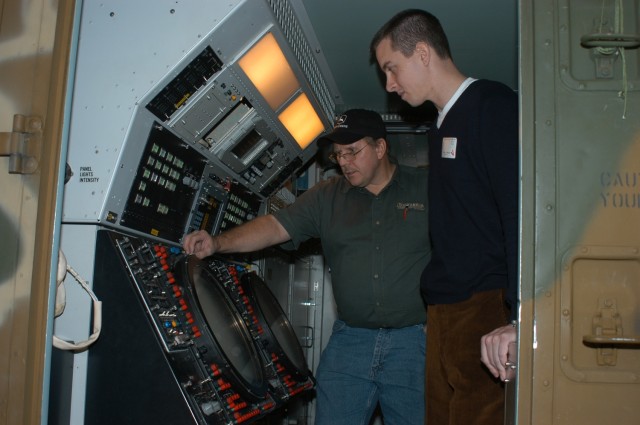
TOBYHANNA ARMY DEPOT, Pa. - An Air Force Air Battle Manager has seen first hand depot support of a key system in air and ground support coordination.
Capt. Dan Johnson, a member of the 729th Air Control Squadron, toured Tobyhanna Army Depot on Dec. 27 to see the support provided to the AN/TPS-75 radar. The 729th is based at Hill Air Force Base, Utah.
"I've had four tours in Southwest Asia in four different locations," he said. "I used the TPS-75 during my last tour."
Johnson's missions were to help manage the air war during Operation Enduring Freedom (Afghanistan) in 2002 and close air support for Operation Iraqi Freedom in 2007.
"The TPS-75 is the primary tool in executing these missions, along with radios," Johnson said. "We use it for air traffic control, coordinating all military aircraft, from fighters to tankers."
Air Battle Managers operate jointly with the Army and Marine Corps, coordinating Air Force fighters, Army helicopters and Marine Corps Unmanned Aerial Vehicles.
Johnson described the experience as similar to fighting a war over O'Hare Airport in Chicago due to the large amount of coordinating and organization needed for smooth operations.
He said that the radars performed well and had a 99.8 percent operational rate for his units, which depend on the TPS-75. He said he knew the radars are refurbished at Tobyhanna through his stepfather, Michael Jones. Jones is the chief of the depot's C3/Avionics Directorate's Transponder Branch.
"We had discussed the TPS-75 because it has Identify Friend or Foe transponder capability, which is what we work on in my branch," Jones explained.
"We used them even during adverse weather," he said. "The systems worked very well due to Tobyhanna and the unit repair crews, so instead of dealing with equipment failures, we could deal with air control and coordinating ground support with the ground commanders."
Johnson noted that the sandstorms in Iraq were little more than a big brown mass of dirt and dust. "There were no clouds, just dust pushed into the air."
Johnson viewed the TPS-75 and associated equipment facilities and saw how the technicians repair and test the radar and the AN/TYQ-23.
The TYQ-23 includes the radar scopes and other equipment used by the controllers. "It is the command center for the TPS-75," said Franklin Frey, chief of the Intelligence, Surveillance and Reconnaissance Directorate's Surveillance Systems Division.
Frey said although the unit repair crews are the first line of repair, Tobyhanna also provides on-site support.
"The system is used worldwide and we provide world wide support, including Mobile Depot Maintenance for emergency repairs and maintenance," he said.
Johnson says he was impressed by the depot's large-scale operations and depot support of the radar and command center. "Tobyhanna-supported equipment is in very good condition," he said.
"I will continue working with the TPS-75 while in my unit and may possibly work with it in the future."
Tobyhanna Army Depot is the Defense Department's largest center for the repair, overhaul and fabrication of a wide variety of electronics systems and components, from tactical field radios to the ground terminals for the defense satellite communications network. Tobyhanna's missions support all branches of the Armed Forces.
About 5,500 personnel are employed at Tobyhanna, which is located in the Pocono Mountains of northeastern Pennsylvania.
Tobyhanna Army Depot is part of the U.S. Army Communications-Electronics Life Cycle Management Command. Headquartered at Fort Monmouth, N.J., the command's mission is to research, develop, acquire, field and sustain communications, command, control, computer, intelligence, electronic warfare and sensors capabilities for the Armed Forces.

Social Sharing